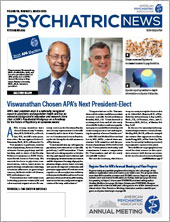A 10-item version of the Positive and Negative Syndrome Scale (PANSS) can reliably assess psychosis symptoms in children and teens, according to a
report in the
Journal of the American Academy of Child and Adolescent Psychiatry.
With the traditional PANSS, which was developed for adults, an interviewer evaluates the patient for 30 symptoms, rating each symptom on a scale of 1 (absent) to 7 (extreme). These symptoms fall under five domains:
•
Positive symptoms (for example, hallucinations and delusions)
•
Negative symptoms (for example, social withdrawal)
•
Excited symptoms (for example, hostility)
•
Cognitive symptoms (for example, poor attention)
•
Affective symptoms (for example, depression and anxiety)
An adult evaluation using the PANSS can take about an hour to administer, which places a burden on both the patient and interviewer, noted Robert L. Findling, M.D., M.B.A., professor and chair of psychiatry at Virginia Commonwealth University School of Medicine. When using the scale to evaluate children and adolescents, the interviewer has discussions with both the youth and their parents, which can add more time.
Other researchers have tested shorter versions of PANSS that attempt to maintain the precision of the 30-item scale while reducing the time it takes to administer the evaluation. These include a 19-item scale and two brief 6-item versions. However, as with the 30-item PANSS, these shortened versions of the scale were developed using adult patient data, Findling explained.
“It’s important that we develop and test a pediatric-specific scale, because while the diagnostic criteria for psychotic disorders are the same for youth and adults, the symptom presentations do differ,” he said.
To create a pediatric PANSS, Findling and colleagues used baseline data from an eight-week clinical trial that compared the safety and efficacy of the antipsychotics olanzapine and risperidone with the older antipsychotic molindone in youth. For that study, which was
published in
The American Journal of Psychiatry, 116 participants aged 8 to 19 years with early onset schizophrenia or schizoaffective disorder were assessed with the 30-item PANSS along with other behavioral assessments every week for eight weeks.
Findling and colleagues evaluated different combinations of symptoms using this patient data set to find a combination that maximized both fidelity to the full-length PANSS (for both mild or severe symptom profiles) and time savings. The researchers sought to include symptoms from the five domains of the 30-item PANSS when creating the pediatric PANSS but did not pick any specific items ahead of time. “We wanted to let the data speak for itself,” he said.
The pediatric PANSS included 10 symptoms evenly spread across the five domains. They were as follows:
•
Delusions and unusual thoughts
•
Emotional withdrawal and apathy
•
Hostility and poor impulse control
•
Inattention and disorganized thinking
•
Anxiety and feelings of guilt
The 10-item PANSS took significantly less time to administer and matched the 30-item PANSS in the AJP data set 88% of the time. It was also accurate for both mild and severe symptom scores and could reliably identify symptom changes over time.
“Overall, I think this shortened version performs pretty well, as it preserves the PANSS’s broad coverage of symptoms in a format that is briefer and easier to interpret,” Findling said. “We need to validate this scale in more diverse populations.”
This study was supported by funding from Signant Health. The trial that provided the data was supported by the National Institute of Mental Health. ■

